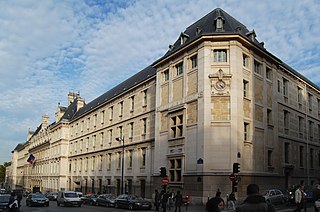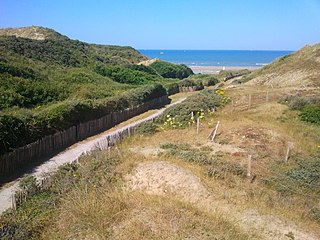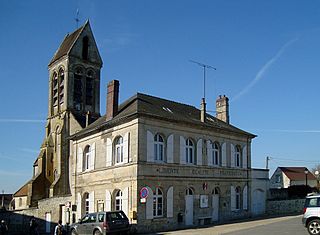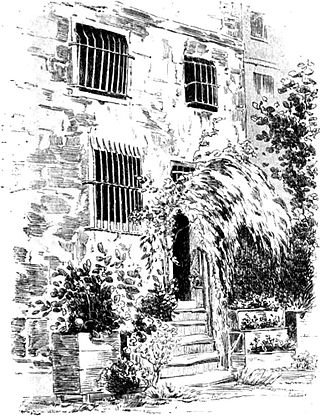
The Lycée Louis-le-Grand, also referred to simply as Louis-le-Grand or by its acronym LLG, is a public Lycée located on rue Saint-Jacques in central Paris.

Fleury-Mérogis is a commune in the Essonne department in northern France, in the southern suburbs of Paris. The commune has the Fleury-Mérogis Prison, France's and Europe's largest prison.

Saint-Étienne-au-Mont is a commune in the Pas-de-Calais department in the Hauts-de-France region of France near Boulogne-sur-Mer. Besides the main settlement Saint-Étienne-au-Mont, the commune consists of the two smaller settlements Pont-de-Briques and Écault.

Marcelin Pleynet is a French poet, art critic and essayist. He was Managing Editor of the influential magazine Tel Quel from 1962 to 1982, and co-edits the journal L'Infini (Gallimard) with Philippe Sollers. He was Professor of Aesthetics at the École nationale supérieure des Beaux-Arts in Paris from 1987 to 1998. He has published numerous monographs on 20th-century art, notably Situation de l’art moderne: Paris-New York, Henri Matisse, Robert Motherwell: La vérité en peinture, Les Modernes et la tradition, Les États-Units de la peinture and L’art abstrait. He has also published books of poetry and the novel Prise d’otage, and an edition of Giorgione et les deux Vénus.

Wimmenau is a commune in the Bas-Rhin department in Grand Est in north-eastern France.

Largny-sur-Automne is a commune in the Aisne department in Hauts-de-France in northern France.

Hipsheim is a commune in the southeast of the Bas-Rhin department in Alsace in north-eastern France.

Wingen-sur-Moder is a commune in the Bas-Rhin department in Grand Est in north-eastern France. The name, literally translated as "Wingen on the Moder", is often shortened to Wingen, although this is the name of a small commune in the Haguenau-Wissembourg arrondissement.

Druyes-les-Belles-Fontaines is a commune in the Yonne department in Bourgogne-Franche-Comté in north-central France, in the natural region of Forterre.

Maillebois is a commune in the Eure-et-Loir department in northern France. The Blaise, a tributary of the Eure, runs through the town.

Hagenthal-le-Bas is a commune in the Haut-Rhin department in Alsace in north-eastern France. The Château de la famille d'Eplingen there has been owned by the town since 2003 and been a listed historical monument since 2010.

Romestaing is a commune in the Lot-et-Garonne département in south-western France.

The Château du Hohlandsbourg or Hohlandsberg is a ruined castle in the commune of Wintzenheim, near Colmar, in the Haut-Rhin département of France. It is open to the public between Easter and 11 November.

The Musée Bartholdi is a museum dedicated to French sculptor Auguste Bartholdi and is situated at 30 rue des Marchands in Colmar, at the artist's birthplace. The museum has the "Musée de France" label. In 2011, the building was labeled "Maisons des Illustres" by the Ministry of Culture and Communication. In the courtyard there is a statue named Statue des grands soutiens du monde. Two doors of the 17th century were registered as a monument historique on 18 June 1926. In 2012, the museum numbered over 16,000 visitors.
The following is a timeline of the history of the city of Metz, France.
The following is a timeline of the history of the city of Clermont-Ferrand, France.

The Carmes Prison was a prison of the French Revolution. It was set up in what had been the Carmes Monastery in Paris. It formed a vast enclosure bounded by rue du Regard, rue du Cherche-Midi and rue Cassette - it was also bordered to the south by rue de Vaugirard. It was the site of one of the September Massacres in 1792 and features in the 1927 film Napoléon.
Haut-Rhin's 7th constituency was a constituency of the French Parliament. It elected one Member of Parliament and was abolished at the 2010 redistricting of French legislative constituencies. The (pre-2015) cantons of Cernay, Ensisheim and Soultz-Haut-Rhin were attached to the revised 4th constituency, while the canton of Guebwiller was moved to the 2nd.
Roger Erell, was a French architect and resistance fighter.















